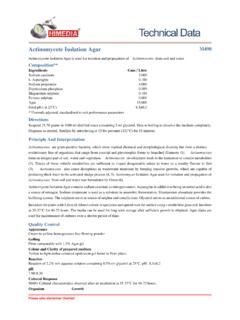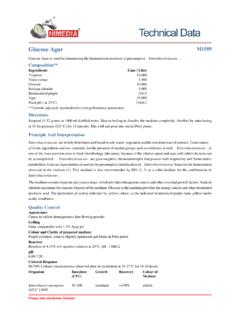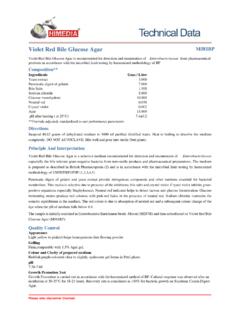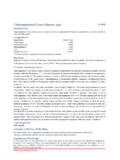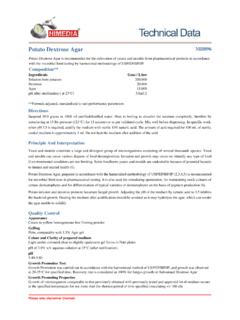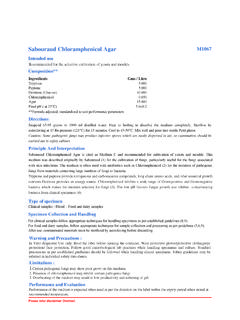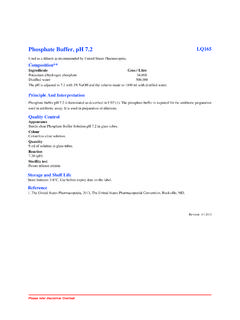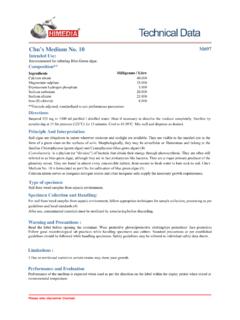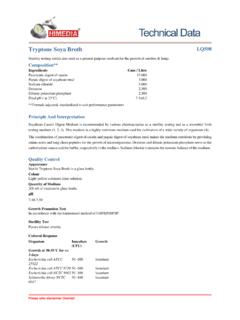Transcription of Modified MYP Agar Base - HiMedia Labs
1 Please refer disclaimer MYP agar BaseM1139 Modified MYP agar base is used for isolation and identification of Bacillus species and pathogenic **IngredientsGms / LitrePeptic digest of animal pH ( at 25 C) **Formula adjusted, standardized to suit performance parametersDirectionsSuspend grams in 900 ml distilled water. Heat to boiling to dissolve the medium completely. Sterilize by autoclavingat 15 lbs pressure (121 C) for 15 minutes. Cool to 55 C. Aseptically add rehydrated contents of 2 vials of sterile PolymyxinB Sulphate (FD003) solution to a final concentration of 100 units per ml and 100 ml sterile Egg Yolk Emulsion (FD045) per1000 ml medium. Mix well and pour into sterile Petri And InterpretationBacillus cereus is ubiquitously present in soil, vegetation water and dust. It has been isolated from a large variety offoods, including vegetables, meat, cereals, pasteurized fresh milk and powdered milk (1, 2, 6) and processed foods.
2 Underfavourable conditions, the organism multiplies and causes gastrointestinal illness (6). It is implicated in two different forms offood poisoning; an emetic illness and a diarrhoeal illness. The emetic illness is mediated by a highly stable toxin that surviveshigh temperature, exposure to trypsin, pepsin and pH extremes. The diarrhoeal illness is mediated by a heat and acid activity is the key reaction in the differential identification of , the most commonly encountered andimportant species in clinical laboratories, from the majority of the other Bacillus species. If unknown isolate produceslecithinase, Bacillus cereus can be presumptively identified by also observing colonial morphology, hemolytic reactivityand motility tests. When present in large numbers in certain foodstuffs, B. cereus can produce metabolites responsible forthe clinical symptoms of food poisoning (3). This medium differentiates from other bacteria based on the basisof lecithinase activity, mannitol fermentation and resistance to polymyxin (FD003) (4, 5).
3 Modified MYP agar has similarcomposition to MYP agar except agar concentration. Recently ISO Committee (9) has recommended Modified MYP Agarfor detection of Staphylococci and MYP agar base contains peptic digest of animal tissue and meat extract, which provide nitrogen source. Mannitolfermentation can be detected by phenol red, which yields yellow colour to the mannitol fermenting colonies due to acidproduction. Added egg yolk emulsion helps in differentiation of lecithinase producing colonies, which are surrounded by azone of white precipitate. Addition of Polymyxin B Sulphate (FD003) helps to restrict growth of gram-negative bacteria suchas Escherichia coli and Pseudomonas aeruginosa . These differentiating media allow differentiation of fromother Bacillus species by its inability to ferment mannitol and poor sporulation. dissimilates egg yolk and givesrise to typical bacilli form colonies with reddish zones and white halos.
4 Acid produced by organisms other than diffuse through the medium, making it difficult to distinguish between mannitol fermenters and non-fermenters. So it isadvised to transfer the suspected colonies to a fresh medium to visualize the true from Modified MYP agar base are subcultured on Nutrient agar and incubated at 30 C for 24 hours to observe/determine vegetative cells, sporangium and spore morphology and lipid globules within vegetative LaboratoriesTechnical DataPlease refer disclaimer ControlAppearanceLight yellow to pinkish purple homogeneous free flowing powderGellingFirm, comparable with agar gelColour and Clarity of prepared mediumBasal medium :Red coloured clear to slightly opalescent gel. After Addition of Egg Yolk Emulsion (FD045) : Light orangecoloured opaque gel forms in Petri platesReactionReaction of w/v aqueous solution at 25 C. pH : ResponseCultural characteristics observed with added Egg Yolk Emulsion (FD045)and Polymyxin B Sulphate(FD003) after anincubation at 32 C for 18-40 ResponseOrganismInoculum(CFU)GrowthRecov eryColour ofcolonyLecithinaseactivityCultural ResponseBacillus cereus ATCC 1087650-100luxuriant>=50%redpositive,opa que zonearound thecolonyBacillus subtilis ATCC 663350-100luxuriant>=50%yellownegativeEs cherichia coli ATCC2592250-100none-poor<=10%NegativeProteus mirabilis ATCC2593350-100luxuriant>=50%rednegativePseudomonas aeruginosaATCC 2785350-100none-poor<=10%NegativeStaphylococcus aureusATCC 2592350-100luxuriant>=50%yellowpositive,opaque zonearound thecolonyStorage and Shelf LifeStore below 30 C in tightly closed container and the prepared medium at 2-8 C.
5 Use before expiry date on the M. S., 1981, Clin. Microbiol. Newsletter 3: for Disease Control: Bacillus cereus- Maine, MMWR, 35: 408-410, D. A. A., Koopman M. J. and Jongerium E., 1967, Appl. Microbiol, 15 F. P. and Ito K., (Eds.), 2001, Compendium of Methods for the Microbiological Examination of Foods, 4th Ed.,APHA, Washington, B., 1962, Acta Path. Microbiol. Scand., 56: Suppl. K. O., 1958, J. Appl. Bacteriol., 21 A. R., 1948, J. Bacteriol., 55 J. and Harmon S. M., 1995, FDA Bacteriological Analytical Manual, 8th Ed., AOAC International,Gaithersburg, Organization for Standardization (ISO), 1993, Draft ISO/DIS : 1 / 2011 HiMedia LaboratoriesTechnical DataHiMedia Laboratories Pvt. Ltd. A-516,Swastik Disha Business Park,Via Vadhani Ind. Est., LBS Marg, Mumbai-400086, India. Customer care No.: 022-61471919 Email: :User must ensure suitability of the product(s) in their application prior to use.
6 Products conform solely to the information contained inthis and other related HiMedia publications. The information contained in this publication is based on our research and developmentwork and is to the best of our knowledge true and accurate. HiMedia Laboratories Pvt Ltd reserves the right to make changes tospecifications and information related to the products at any time. Products are not intended for human or animal or therapeutic use butfor laboratory,diagnostic, research or further manufacturing use only, unless otherwise specified. Statements contained herein should notbe considered as a warranty of any kind, expressed or implied, and no liability is accepted for infringement of any patents.
